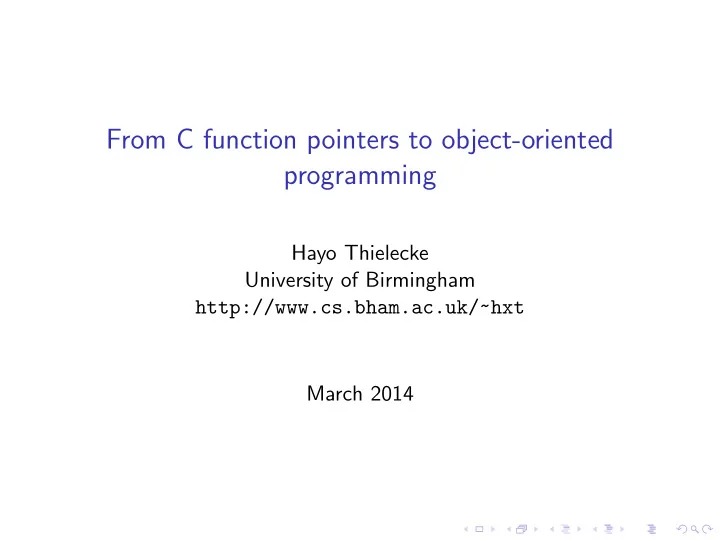

From C function pointers to object-oriented programming Hayo Thielecke University of Birmingham http://www.cs.bham.ac.uk/~hxt March 2014
Objects and C ◮ C gives us primitive building blocks ◮ struct, pointers, functions ◮ What we do with them is up to us ◮ How far can we push C? ◮ How about objects? ◮ We will assume: virtual functions as fundamental for OO ◮ Early C++ was a preprocessor for C ◮ Advanced example of pointers in C ◮ Some idea of how C++ is implemented
OO in C: two key pointers In C++ we write a virtual function call as left->print(); Simulated in C, this becomes: thisp->left->vptr->print(thisp->left); Give each function access to object via “self” or “this” pointer Call virtual function indirectly through virtual function table
Example class in C++ Canonical example of OO: parse trees for expressions virtual functions for processing trees class Expression { public : virtual int eval () = 0; virtual void print () = 0; };
Virtual function table in C: types structure + pointer + function: struct vtbl { void (* print)(); int (* eval)(); }; Base class has pointer to vtbl: struct ExpressionOO { struct vtbl *vptr; };
Derived class via physical subtyping struct Constant { struct vtbl *vptr; int n; }; In memory: ExpressionOO: Constant: vptr vptr n Position of vptr is the same.
Virtual member functions populate the vtable void printConstant(struct Constant *p) { printf("%d", p->n); } int evalConstant(struct Constant *p) { return p->n; } Global variable for vtable, containing function pointers struct vtbl vtblConstant = { &printConstant , &evalConstant };
Constructor malloc and intialize, including vptr void *makeConstantOO (int n) { struct Constant *p; p = malloc(sizeof(struct Constant)); if(p == NULL) exit (1); p->n = n; p->vptr = &vtblConstant; return p; }
Another derived class, for plus struct Plus { struct vtbl *vptr; struct ExpressionOO *left; struct ExpressionOO *right; }; In memory: ExpressionOO: Plus: vptr vptr left right
Virtual member functions void printPlus(struct Plus *thisp) { thisp ->left ->vptr ->print(thisp ->left); printf(" + "); thisp ->right ->vptr ->print(thisp ->right); } The eval function: int evalPlus(struct Plus *thisp) { return thisp ->left ->vptr ->eval(thisp ->left) + thisp ->right ->vptr ->eval(thisp ->right); }
Virtual function table for plus struct vtbl vtblPlus = { &printPlus , &evalPlus };
Constructor for plus void *makePlusOO(struct ExpressionOO *left , struct ExpressionOO *right) { struct Plus *p; p = malloc(sizeof(struct Plus)); if(p == NULL) exit (1); p->vptr = &vtblPlus; p->left = left; p->right = right; return p; }
Using it struct ExpressionOO *p1 , *p2 , *p3 , *p4 , *p5 , *p6 , *p7; p1 = makeConstantOO (1); p2 = makeConstantOO (2); p3 = makeConstantOO (3); p4 = makeConstantOO (4); p5 = makePlusOO(p1 , p2); p6 = makePlusOO(p3 , p4); p7 = makePlusOO(p5 , p6); printf("\nTesting print 1 + 2 + 3 + 4\n"); p7 ->vptr ->print(p7);
OO in C: two key pointers In C++ we write a virtual function call as left->print(); Simulated in C, this becomes: thisp->left->vptr->print(thisp->left); Give each function access to object via “self” or “this” pointer Call virtual function indirectly through virtual function table
Conclusions on C ◮ C is simple, powerful and flexible ◮ nothing superfluous ◮ pointers ◮ control over memory ◮ physical subtyping ◮ function pointers ◮ static type checking, up to a point ◮ type system is not a straightjacket
Recommend
More recommend